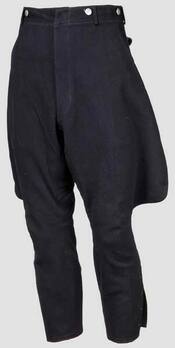Kriegsmarine Blue Breeches
SKU: 21.GOR.02.03.01.003
Estimated market value:

Estimated market value:
Attributes
History
The headgear, uniforms, and insignia worn by members of the Kriegsmarine were based upon the designs utilized by the Kaiserliche Marine and the Reichsmarine. The official regulations governing the uniforms of the Reichsmarine were issued on April 5, 1921, and they were embraced, with a few alterations, as the Kriegsmarine uniforms in 1935.
From 1933-1945, the uniforms worn by personnel in the German Navy were produced and disseminated by the Navy Clothing Depot and private manufacturers. The cloth was of a high quality prior the Second World War, but during the war, it became increasingly synthetic. Similarly, the cloth used in the uniforms of Officers and Admirals was of a higher quality than the cloth used in the uniforms of lower ranking personnel, such as Non-Commissioned Officers. The cloth utilized in garments of the blue uniform is of an overall better quality that the cloth utilized in the field-grey uniform. For the field-grey uniform specifically, the cloth is more grey-coloured in pre-Second World War uniforms, while the cloth is more green/olive-coloured in Second World War uniforms.
The buttons worn on Kriegsmarine trousers are generally composed of metal or plastic.
The garments may have proof stamps, serial and unit stamps, and manufacturer marks denoting the legitimacy and origin of the item. They also tend to feature sewn name tabs (namensläppchen) on all clothing items associated with the blue and field-grey uniforms. The blue uniform garments all have a serial number stamp (stammrollennummernstempel), while the field-grey uniform garments have a unit stamp.
The proof stamp is present on all garments produced by the Navy Clothing Depot, and it includes the size of the item, if needed, with the year of manufacture above the size, and a surmounting script that reads “B.A.K.” or “B.A.W.” This stamp information is framed, and written in white ink on blue or black garments and in black ink on all other colour garments.
The serial stamp is composed of letters and numbers, and it is present on blue uniform garments from the Depot. The stamp is either printed in red ink or sewn in red thread. The numbers are preceded by a letter that denotes the area in which the wearer served, with an “N” for Navy Station or an “O” for Navy Station Baltic. The stamp ends in a letter associated with the wearer’s career group, with an “S” for deck personnel and a “T” for technical professionals. Below the serial number is the year in which the wearer entered the navy, surmounted by a horizontal line.
The unit stamp is present on field-grey uniforms. It includes the framed, shortened unit name of the wearer in red ink.
The marks of private manufacturers vary widely, ranging from codes to full names, and even abbreviated letters, as well as the year of manufacture. After 1942, Reich numbers (Reichsbetriebsnummer) were also used as manufacturer marks (RB-).
The Breeches were primarily worn by Officer ranks, but they could also be worn by Officer Candidates and Senior Non-Commissioned Officers. These breeches were worn as part of the parade dress and landing dress, and they were also worn while riding or participating in riding lessons.
These breeches were produced in two models, the riding breeches (reithose) and the regular breeches (stiefelhose). They are almost identical, only differing in the use of seat trimming; the riding breeches feature a leather or cloth trimming on the seat of the breeches, the crotch, and along the inner thighs.
The breeches are composed of several main elements, including the cloth panels, the front closure fly/flap, the pockets, and the lower leg slash.
These breeches were worn with the blue uniform, the tropical uniform, and the field-grey uniform. For the blue uniform they were predominately produced from navy blue tricot cloth, but variations exist as a result of private manufacture. The tropical uniform breeches were made from tan-coloured cotton fabrics with white lining, and the field-grey uniform breeches were made from grey cotton fabric with reinforcing grey twill along the edges of the leg slash. When breeches for all uniforms were purchased by Officers from private manufacturers the cloth quality is of a higher quality, and the trimming of the riding breeches is more likely to be made from leather.
Similarly, while the majority of Kriegsmarine breeches were made with a five-button fly closure, there are numerous breeches also manufactured with front flap closures. The flap closure features four buttonholes, and each front panel has two buttons along the waistband.
There are two slash pockets with a button closure at each hip, and two slash pockets on the back panels with a scalloped flap cover and a button.
The breeches have a slash from directly below the knee to the bottom of the leg. These slashes are held together by three to seven buttons, or by cords that lace through eleven eyelets.

Versions
$250 USD


Comments
Sign in to comment and reply.


Scroll Top